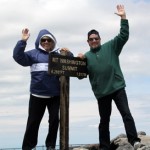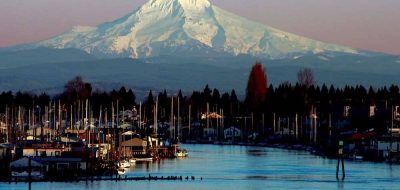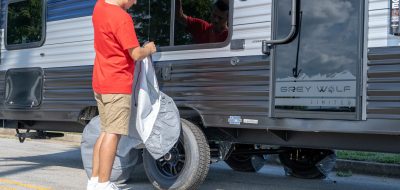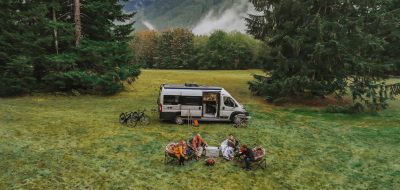We’ve all heard the term “your tax dollars at work”. All too often it seems to be uttered in sarcasm after an unfortunate delay or mistake made from somewhere within a government agency. But take heart: your tax dollars are also going toward some of the best rewards an RV owner could possibly ask for— public lands that are yours to use for the asking.
Actually, most of the time you barely need to even ask before using them; while reservations are always a great idea, many of the campgrounds that are located in US Forest Service (USFS), Bureau of Land Management (BLM) or National Park Service (NPS) lands allow you to simply pull up and, space allowing, pay a small reservation fee (or flash a Golden Eagle Pass) and pull in.
With millions of acres of protected wilderness to explore, we turn to Gale Norton, former Secretary of the Interior, to weigh in with her thoughts about how some campgrounds and visitor centers located in National Parks and on BLM and USFS lands are reporting fewer visitors than in years past.
Norton, who also served as the attorney general for Colorado from 1991 until 1999, was appointed to the position of Interior Secretary in 2001—a position that oversaw the management of the National Park Service, the Bureau of Land Management, the Bureau of Reclamation, Fish and Wildlife Services and the Bureau of Indian Affairs – and was the first woman to head the 157-year old agency. She resigned her post earlier this spring to do more of what she loves best…explore the great outdoors.
Q: When you speak to groups now, it’s just as often to retailers, people who manufacture or sell recreational items, as it is to everyday folks getting outdoors for fun. What’s the difference in the message or in the reception to what you have to say?
Gale Norton: I (see) a lot of enthusiasm. People are very pleased to have a focal point for a campaign to get people outdoors. When you look at it from the average person’s perspective, in the historical perspective, I think that people a few generations ago were very used to being outdoors. Perhaps they grew up on a farm or their parents grew up on a farm or somebody introduced them to the outdoors…we didn’t have the competition of TVs and video games!
And today’s newer generations are much different than that. There are some schools that make an effort to get kids outdoors. I’ve seen school kids and teachers at wildlife refuges and National Parks learning about the outdoors (but) the educational system can’t be relied on to really take major responsibility for getting people into the outdoors. If people don’t have the initial introduction through family or school, then it’s hard for them to overcome the fear of not knowing where to start.
Q: Focusing in on the National Parks then for a second, are the numbers of people taking advantage of what National Parks have to offer—day use, overnight use, naturalist lectures, etc.—going up or down?
Gale Norton: Unfortunately, the trend is that use (of National Parks) is going down. There are a couple of reasons and it focuses on a few areas. The standard family vacation we used to think of a few decades ago—the loading of the family into the station wagon and touring the National Parks—doesn’t happen as much when gasoline costs $3 a gallon. Plus, maybe even more importantly, families don’t tend to spend as much time together as they used to and so you don’t see that pattern of visitation as much as you once did.
So, while some parks stay very popular, in general the ‘attendance’ at many parks is way down. For example, one that I know (about) directly from a conversation with the Superintendent a few years ago, is Carlsbad Cavern. The visitation there is down, I think, by about a third from what its peak once was.
Q: So, how much of this change in visitation that we’re seeing, do you think, is really about the price of gasoline versus other factors?
Gale Norton: I don’t think there’s one single factor. On the gasoline front, if you make people aware of recreation opportunities that are closer to home, they may learn that there are opportunities closer than they knew about (and) they may take advantage of that opportunity.
For example, I know we did a centennial celebration for the Wildlife Refuges where we were trying to educate people that there is a wildlife refuge within an hour’s drive of almost every major city!
So it’s a great place to go and see wildlife, talk with people who are knowledgeable about wildlife and a great overall opportunity to get out and be active. Unfortunately, not a lot of people know about the opportunities close by.
Q: So that brings up another important point; if it’s a choice between taking the family to Disneyland or to a National Park for a long weekend or vacation, how does that decision get made? Do you think most adults planning a recreation trip understand that their tax dollars paid for, or are paying for, access to National Parks?
Gale Norton: There are so many great opportunities out there and I think that people don’t realize what’s waiting for them to simply take advantage of. There is, however, a great place for people to go to for more information about where to go and that has lots of great information; it’s recreation.gov. It lists public lands and recreation opportunities all across the country. There’s also usually information available when people arrive at a particular area and in almost every (campground) there’s going to be knowledgeable staff who will be happy to answer questions and provide information.
These are public lands, paid for by the people and their government. I think a lot of people really don’t know the economics of the system and they don’t realize for one thing just how much work is involved in maintaining those public lands. They don’t realize what it takes to keep campgrounds open and have rangers available and so I think there are a lot of people who don’t realize how much both public and private effort is necessary for a gateway community to be able to welcome visitors and for the public land areas to provide the availability of recreation areas.
Q: Any personal destination favorites that you want to share with us?
Gale Norton: I certainly love the Rockies and the great mountains parks in the Rockies…Rocky Mountain National Park, Glacier National Park and Grand Teton National Park are just fantastic places with the ability for people to get away from crowds. One thing people often used to think about the more popular national parks is the idea that there will be big crowds. And, yes, there may be crowds in the height of the season at the most popular spot, but if people will take time to get off the beaten path there are so many places where you can enjoy solitude and really connect with the outdoors.
Also, I think another thing that people should realize is that there are a lot of national parks that aren’t necessarily the ones that you can rattle off the top of your head when you think of the names of parks but that are wonderful. In my home state of Colorado, for example, you have the Great Sand Dunes National Park and Black Canyon at the Gunnison. These are places that have spectacular scenery and far less visitation than Rocky Mountain National Park.
Q: So how do we introduce a new generation or two to not only the National Parks but to all of the outdoor recreation options just waiting out there?
Gale Norton: Well, I’d like to ask every RV owner reading this (laughs) that if there is a young person that they care about that they have an obligation to think about how they can connect that young person to the outdoors.
Very often those kids are going to be sitting watching TV or playing video games and unless someone takes them by the hand and shows them the outdoors, they’re not going to be participating in those activities when they become adults. I think it’s very important to have that personal connection as well as industry and government, and schools all doing their parts to introduce people to the outdoors.
Q: How about volunteer opportunities? Are those a good way to get involved in the outdoors, either for the first time or as a way to meet new people, see new things?
Gale Norton: Absolutely. It’s so important that people take care of these lands. They’re our lands! We hope that people will take time to learn the outdoor ethic and there’s a group that has a title that captures it pretty well called: “Leave No Trace.” It’s basically the idea that people ought to be responsible in their camping and in their use of the outdoors to protect the wildlife and the scenery for people to enjoy in the future.
One of my pride and joy activities while at the Department of the Interior was a program called “Take Pride in America.” It’s a volunteer program encouraging people to work on outdoor projects. It could be in a national park or wildlife refuge, or it could be in a local park or a beach. There’s such an incredible variety of opportunities, everything from elementary school kids picking up litter to people in Hawaii working to eradicate invasive species destroying coral to folks helping
restore areas after the hurricanes or restoring areas damaged by wildfires. It’s a great way to meet others, too; go for a clean up day at a local beach, clean up a whole pile of trash, get your picture taken in front of the big pile of trash, and have a barbecue!
One example that I love to use and which is a great volunteer activity is one where there were some enthusiastic bird watchers who were available on weekends at wildlife refuges to point out various birds to those who are brand new to the idea of bird watching. So that doesn’t require great physical stamina. It’s something where people can share their areas of interest.
Q: Any particular ideas about volunteers who are traveling in their RVs?
Gale Norton: Sure! Another opportunity for those who have more time would be to serve in the campgrounds themselves. There are opportunities for people to go and spend a few weeks or even a few months at a particular campground and work to expand the ability of the professional rangers by watching over the campground, handing out maps, that kind of thing.
Q: Are these volunteer opportunities paid opportunities?
Gale Norton: Most of them, I think, are basically volunteer work in exchange for the opportunity to park for free at a campground but there are also a couple of websites where interested RVers can go for more information; takepride.gov and volunteer.gov. There are always great opportunities out there and one for just about every person’s interest. It’s really about just getting out there!






